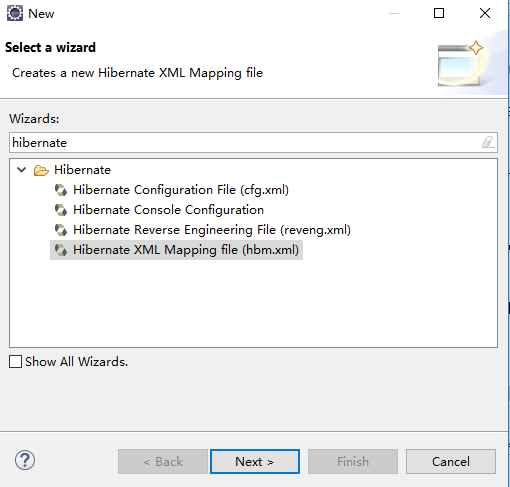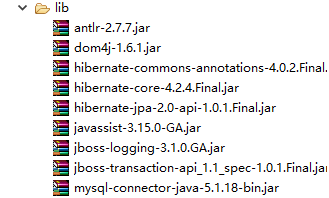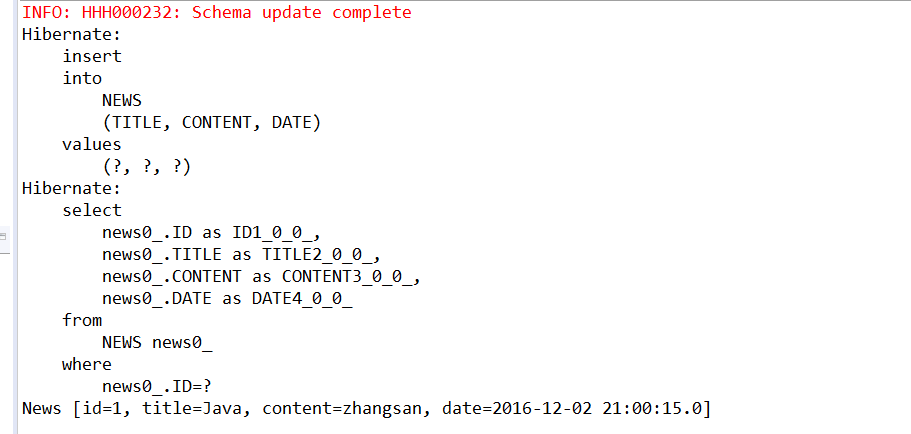在Eclipse下搭建Hibernate框架
實現在Eclipse中搭建一個Hibernate框架。在這裡,我使用的資料庫是mysql5.5。
1.安裝和當前Eclipse版本匹配的Hibernate外掛或者JBoss外掛:
在Eclipse中點選Help —> Eclipse Marketplace,搜尋JBoss Tools,點選install,選擇要安裝的JBoss外掛(我選擇了全部),一路預設即可,安裝完後重啟Eclipse。
重新開啟Eclipse後,右鍵New -> Other,輸入hibernate會提示

表明Hibernat外掛安裝成功。
2.新建專案,並搭建Hibernate環境:
右鍵New -> Java Project(僅需測試Hibernate,故沒有新建Web Project),右鍵專案名,New -> Folder,命名為lib,複製需要的hibernate的JAR檔案和mysql的JAR檔案到該資料夾下:

右鍵這些jar檔案,Build Path -> Add to Build Path。
3.建立持久化Java類:(在這裡用一個新聞類News.java測試)
import java.util.Date;
public class News {
private Integer id;
private 注意點:
- 要提供一個無參構造器。以便Hibernate可以使用Constructor.newInstance()來例項化持久化類。
- 提供一個標識屬性。通常對映為資料庫表的主鍵欄位。如果沒有該屬性,一些功能將不起作用,如:Session.saveOrUpdate()。
- 為持久化類的欄位宣告訪問方法(get/set)。Hibernate對JavaBeans風格的屬性實行持久化。
- 使用非final類。在執行時生成代理是Hibernate的一個重要的功能。如果持久化類沒有實現任何介面,Hibnernate 使用 CGLIB 生成代理。如果使用的是 final 類,則無法生成CGLIB代理。
- 重寫eqauls()和hashCode()方法。如果需要把持久化類的例項放到Set中(當需要進行關聯對映時),則應該重寫這兩個方法。
4.建立物件-關係對映檔案:
右鍵持久化類所在的包名,New -> Hibernate XML Mapping file(hbm.xml) -> 選擇News類 -> finish,將生成New類對應的物件-關係對映檔案News.hbm.xml,把其中<id>下的<generator>的class屬性設定為”native”,即指定主鍵的生成方式為使用資料庫的本地方式:
<?xml version="1.0"?>
<!DOCTYPE hibernate-mapping PUBLIC "-//Hibernate/Hibernate Mapping DTD 3.0//EN"
"http://hibernate.sourceforge.net/hibernate-mapping-3.0.dtd">
<!-- Generated 2016-12-2 16:03:18 by Hibernate Tools 3.5.0.Final -->
<hibernate-mapping>
<class name="com.Hibernate.entities.News" table="NEWS">
<id name="id" type="java.lang.Integer">
<column name="ID" />
<!-- 指定主鍵的生成方式, native: 使用資料庫本地方式 -->
<generator class="native" />
</id>
<property name="title" type="java.lang.String">
<column name="TITLE" />
</property>
<property name="content" type="java.lang.String">
<column name="CONTENT" />
</property>
<property name="date" type="java.util.Date">
<column name="DATE" />
</property>
</class>
</hibernate-mapping>5.建立Hibernate配置檔案:
右鍵src目錄 -> New -> Hibernate Configuration File -> next,使用預設名字hibernate.cfg.xml,點選finish,然後在該檔案中配置資料庫連線相關的資訊:
<?xml version="1.0" encoding="UTF-8"?>
<!DOCTYPE hibernate-configuration PUBLIC
"-//Hibernate/Hibernate Configuration DTD 3.0//EN"
"http://hibernate.sourceforge.net/hibernate-configuration-3.0.dtd">
<hibernate-configuration>
<session-factory>
<!-- 配置連線資料庫的基本資訊 -->
<property name="connection.username">root</property>
<property name="connection.password">你的資料庫密碼</property>
<property name="connection.driver_class">com.mysql.jdbc.Driver</property>
<property name="connection.url">jdbc:mysql:///資料庫名</property>
<!-- 配置 hibernate 的基本資訊 -->
<!-- hibernate 所使用的資料庫方言 -->
<property name="dialect">org.hibernate.dialect.MySQL5InnoDBDialect</property>
<!-- 執行操作時是否在控制檯列印 SQL -->
<property name="show_sql">true</property>
<!-- 是否對 SQL 進行格式化 -->
<property name="format_sql">true</property>
<!-- 指定自動生成資料表的策略 -->
<property name="hbm2ddl.auto">update</property>
<!-- 指定關聯的 .hbm.xml 檔案 -->
<mapping resource="com/atguigu/hibernate/helloworld/News.hbm.xml"/>
</session-factory>
</hibernate-configuration>6.測試:
右鍵 -> New -> JUnit Test Case,用下面的程式碼測試儲存一個New物件到資料庫,然後查詢該記錄並輸出。
public class Test {
@org.junit.Test
public void test() {
//1.建立一個 SessionFactory 物件
SessionFactory sessionFactory = null;
//1).建立Configuration物件:對應hibernate的基本配置資訊和物件關係對映資訊
Configuration configuration = new Configuration().configure();
// Hibernate4.0之前這樣建立
//sessionFactory = configuration.buildSessionFactory();
//2).建立一個 ServiceRegistry 物件: hibernate 4.x 新新增的物件
//hibernate 的任何配置和服務都需要在該物件中註冊後才能有效.
ServiceRegistry serviceRegistry =
new ServiceRegistryBuilder().applySettings(configuration.getProperties())
.buildServiceRegistry();
//3).
sessionFactory = configuration.buildSessionFactory(serviceRegistry);
//2. 建立一個 Session 物件
Session session = sessionFactory.openSession();
//3. 開啟事務
Transaction transaction = session.beginTransaction();
//4.執行儲存和載入操作
News news = new News("C++", "zhangsan", new Date(new java.util.Date().getTime()));
session.save(news);
//載入資料庫中id為1的News記錄
News news1 = (News) session.get(News.class, 1);
System.out.println(news);
//5. 提交事務
transaction.commit();
//6. 關閉 Session
session.close();
//7. 關閉 SessionFactory 物件
sessionFactory.close();
}
}執行程式碼後,會自動為資料庫hibernate1建立一張news表,並新增一條記錄:

而且在控制檯輸出了sql語句以及從資料庫中載入的記錄:

在test方法中,各個介面的作用為:
- Configuration介面:
Configuration 類負責管理 hibernate 的配置資訊,包括如下內容:
Hibernate 執行的底層資訊:資料庫的URL、使用者名稱、密碼、JDBC驅動類;
資料庫Dialect,資料庫連線池等(對應 hibernate.cfg.xml 檔案);
持久化類與資料表的對映關係(對應*.hbm.xml 檔案)。
建立 Configuration 的兩種方式:(只一種即可,否則會被覆蓋)
屬性檔案(hibernate.properties):
Configuration cfg = new Configuration();Xml檔案(hibernate.cfg.xml):
Configuration cfg = new Configuration().configure();
Configuration 的 configure 方法還支援帶引數的訪問:
File file = new File(“new.xml”);
Configuration cfg = new Configuration().configure(file);- SessionFactory介面:
針對單個數據庫對映關係經過編譯後的記憶體映象,是執行緒安全的。
SessionFactory物件一旦構造完畢,即被賦予特定的配置資訊。
SessionFactory是生成Session的工廠。
構造SessionFactory很消耗資源,一般情況下一個應用中只初始化一個SessionFactory物件。
Hibernate4新增了一個ServiceRegistry介面,所有基於Hibernate的配置或者服務都必須統一向這個ServiceRegistry 註冊後才能生效。
Hibernate4中建立SessionFactory的步驟:
//建立Configuration物件
Configuration configuration = new Configuration().configure();
//建立ServiceRegistry物件
ServiceRegistry serviceRegistry = new ServiceRegistryBuilder()
.applySettings(configuration.getProperties())
.buildServiceRegistry();
//建立SessionFactory物件
SessionFactory sessionFactory = configuration.buildSessionFactory(serviceRegistry);Session介面:
Session 是應用程式與資料庫之間互動操作的一個單執行緒物件,是 Hibernate運作的中心,所有持久化物件必須在session的管理下才可以進行持久化操作。此物件的生命週期很短。Session物件有一個一級快取,顯式執行flush之前,所有的持久層操作的資料都快取在session物件處。相當於JDBC中的Connection。
持久化類與 Session關聯起來後就具有了持久化的能力。
Session 類的方法:
取得持久化物件的方法: get()load();
持久化物件都得儲存,更新和刪除:save(),update(),saveOrUpdate(),delete();
開啟事務: beginTransaction();
管理 Session的方法:isOpen(),flush(),clear(), evict(), close()等。Transaction介面:
代表一次原子操作,它具有資料庫事務的概念。
所有持久層都應該在事務管理下進行,即使是隻讀操作。
獲取Transaction物件:
Transaction transaction = session.beginTransaction(); 常用方法:
commit():提交相關聯的session例項;
rollback():撤銷事務操作;
wasCommitted():檢查事務是否提交。
